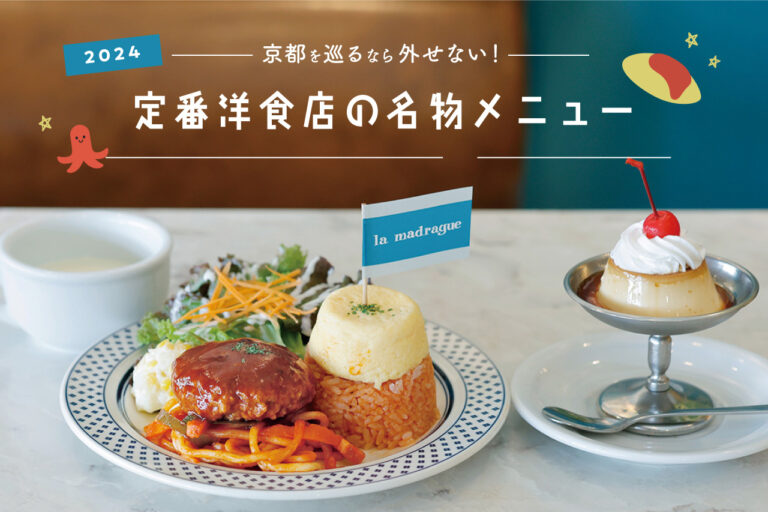
2024] Latest! 21 Popular Western-style Restaurants in Kyoto
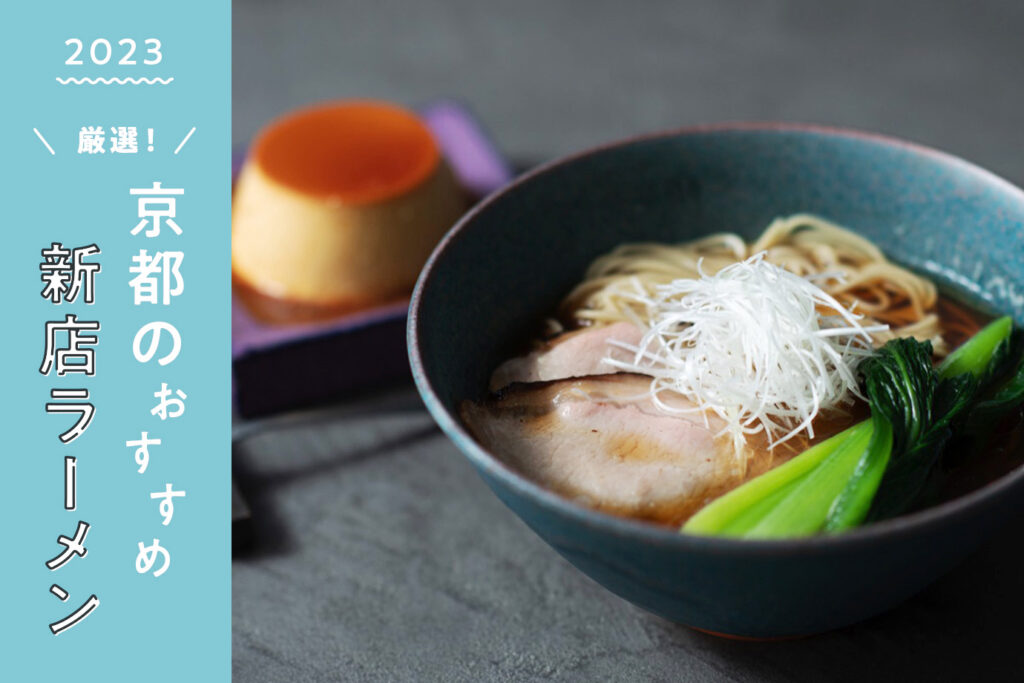

Among the latest ramen stores in Kyoto, we pick out the newest and most noteworthy! We will provide you with the information you should keep in mind now in Kyoto, a hot ramen battleground.
Mr. Yamada, the owner of Ikkyuan's, an udon and soba restaurant that has been loved for its additive-free Japanese-style dashi, has launched a ramen specialty restaurant specializing in dashi-scented ramen. The dashi soy sauce ramen, flying fish dashi ramen, shellfish dashi ramen, and other ramen dishes all have a rich and subtle flavor, which can be changed midway through the meal using freshly shaved bonito flakes. The TKM (tamagokakemen), which includes a raw egg, seaweed, and dried bonito, can be enjoyed with a bowl of rice topped with a dibu-meshi (rice cake) for an extra 60 yen to savor every last bite.
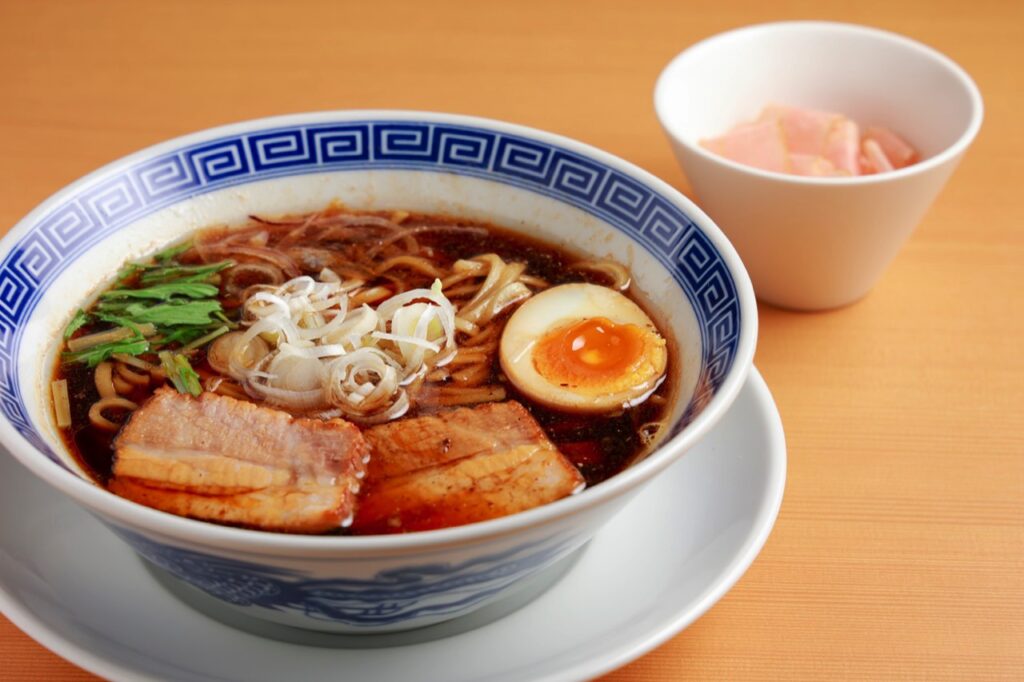
Dashi Shoyu Soba with a broth made from seven kinds of chicken broth and dried fish, and chewy noodles with a lot of water on the top, all poured on top of the tamari soy sauce used for the Imperial Household Agency's order. 890 yen.

Miyamoto Curry, which attracted attention when it was transformed from a bar to a curry restaurant as part of a TV project, has now turned into a ramen restaurant. Its signature menu item is spiced ramen, which was created by rearranging the original curry recipe. The soup is made from a unique blend of about seven spices, with secret ingredients such as white miso paste and kaeshi (a Japanese sweet bean paste) added to give it a Japanese flavor. The soup is also characterized by its many ingredients, including the sourness of the tomatoes, which go well with the spices and accentuate the flavor.
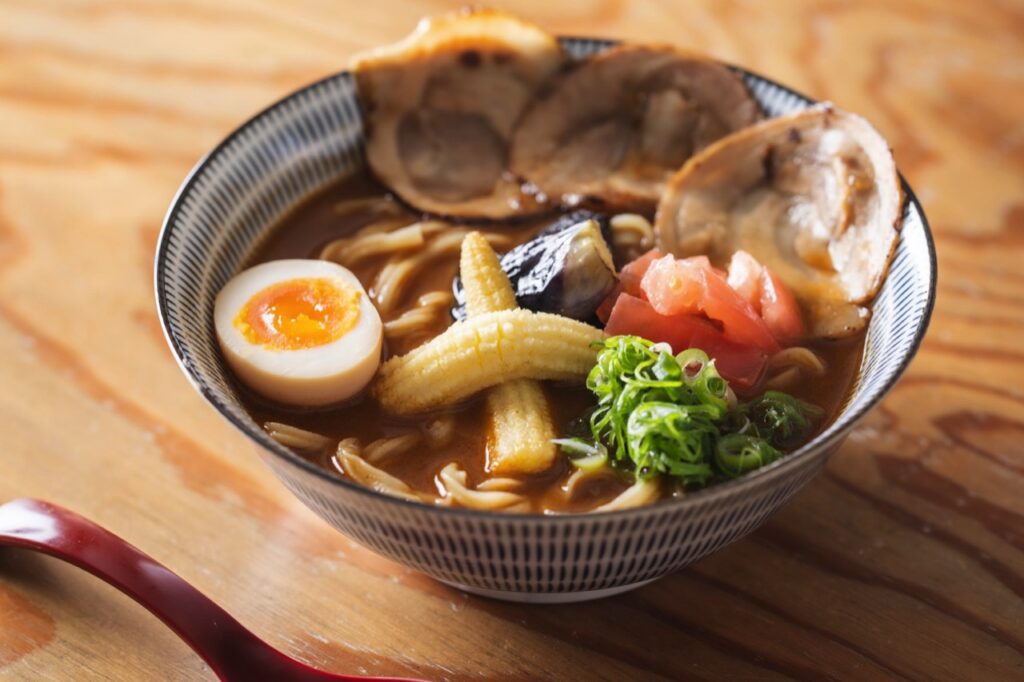
Spiced ramen 900 yen. Original spices blended for flavor, spiciness, and efficacy are combined with chicken broth to create a rich, umami-rich flavor. The spiciness that comes afterwards is impressive and addictive!

The soup is made with broth made from kombu (kelp) and iriko (dried sardines). In addition, mackerel, eel, and bonito flakes are added to give the soup a rich, deep, and aromatic flavor. The homemade medium-thick, straight noodles are made from a blend of four types of wheat. One of them is durum for pasta, which gives the noodles a crisp, chewy texture. The special order of the brand TOKINOHA, which is made by Mr. Obinoha, is also a special feature. It enhances the flavor of the ramen.
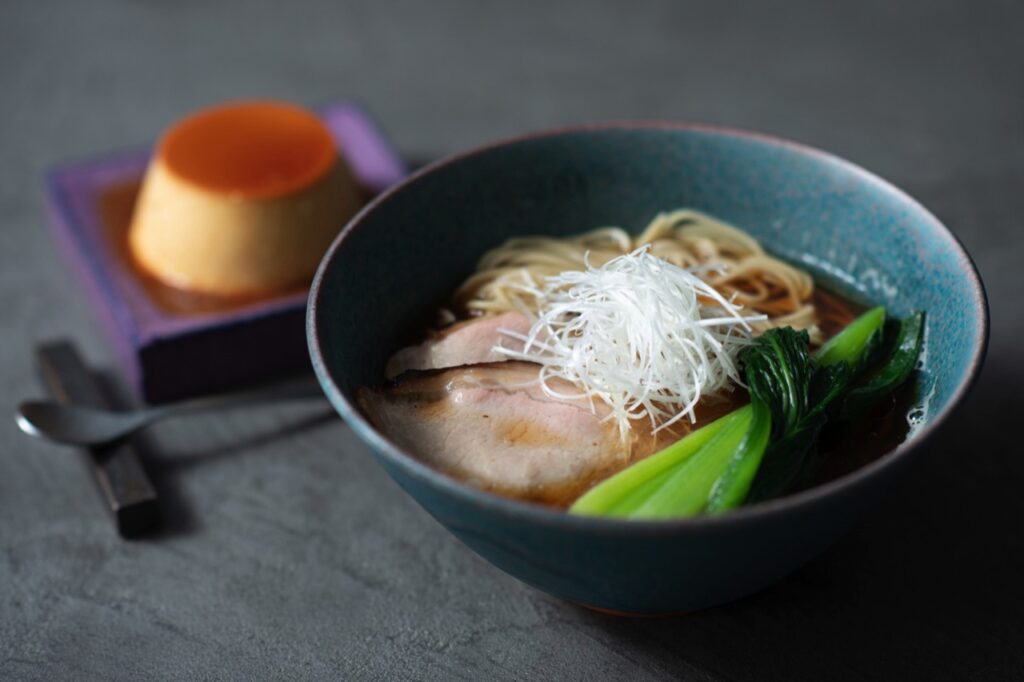
The light soup is well mixed with thick, medium-thick straight noodles. The chashu pork is Kyoto's glutinous pork. It is marinated in homemade sauce, roasted, and then cooked at low temperature.

GOTSUJI NO KONBU, a long-established restaurant in business for more than 120 years, has started a new venture. In a stylish space with gray walls and a wooden counter, you can enjoy a course of kelp ramen. First, after comparing mizu-dashi (water-dried kelp) from Makon, Rausu, and Rishiri kelps in a wine glass, the Oboro kelp, which is shaved in front of you by Mr. Kuze, the representative of the restaurant, appears. Enjoy the kelp ramen with its soft and moist texture and the elegant aroma of the broth.
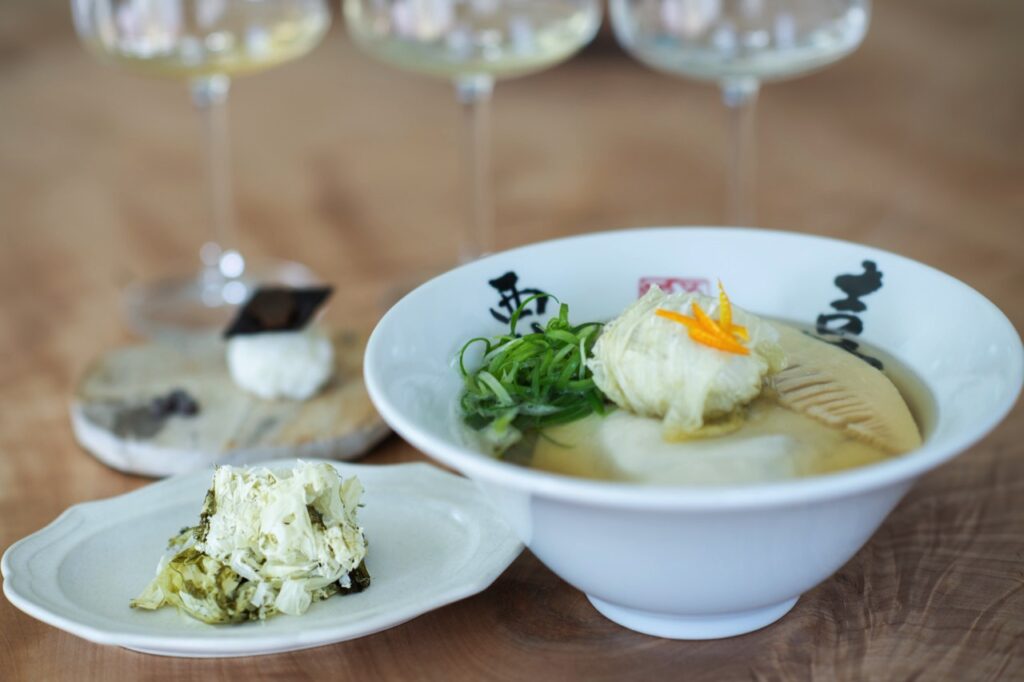
Kombu Ramen 1152 yen. The clear, beautiful soup is made from Makonobu, Rausu, and Rishiri kelp, which is slowly drained for half a day and then heated just before serving. It is refreshing and full of flavor.

[Tetsuya Tamura, owner of BRULEE KYOTO, is taking on a new challenge with his ramen restaurant. He and his friend, who is a ramen chef, developed soupless noodles that have a punch but are not spicy. The special sauce made by blending pork bone soup and three kinds of soy sauce, boiled dried oil, and extra-thick noodles from Noodle Egbe are combined with many appetizing toppings such as flavored eggs and fried onions.
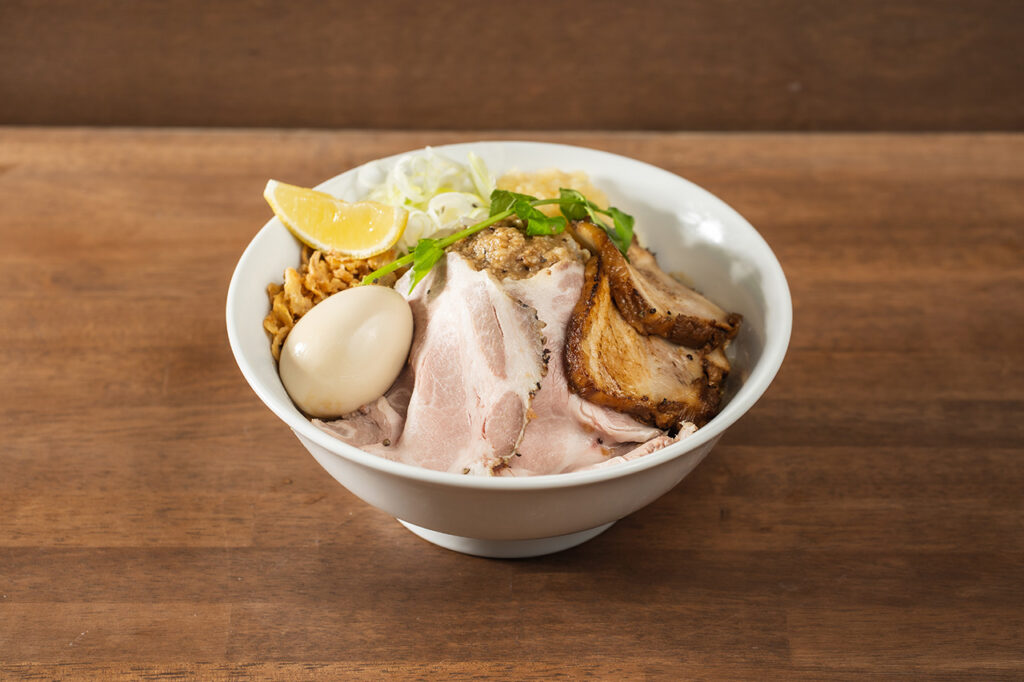
Special double soba noodles without chashu soup 1,350 yen. The chewy noodles are coated in a punchy sauce. The watercress topping is a nice accent

Ramen SHO, the ramen brand of Karaage Specialty Restaurant Kokoro-kara, located in the same shopping arcade, is now available. The owner, Mr. Masashi Shiota, has been pursuing his own personal taste just as much as he does with karaage, and you can enjoy a bowl of his best. The pork-bone based soup uses a salty soy sauce as the "Kaeshi" (sweetening agent). The Akira-style ramen is easy to eat for both children and adults, and does not contain any back fat.
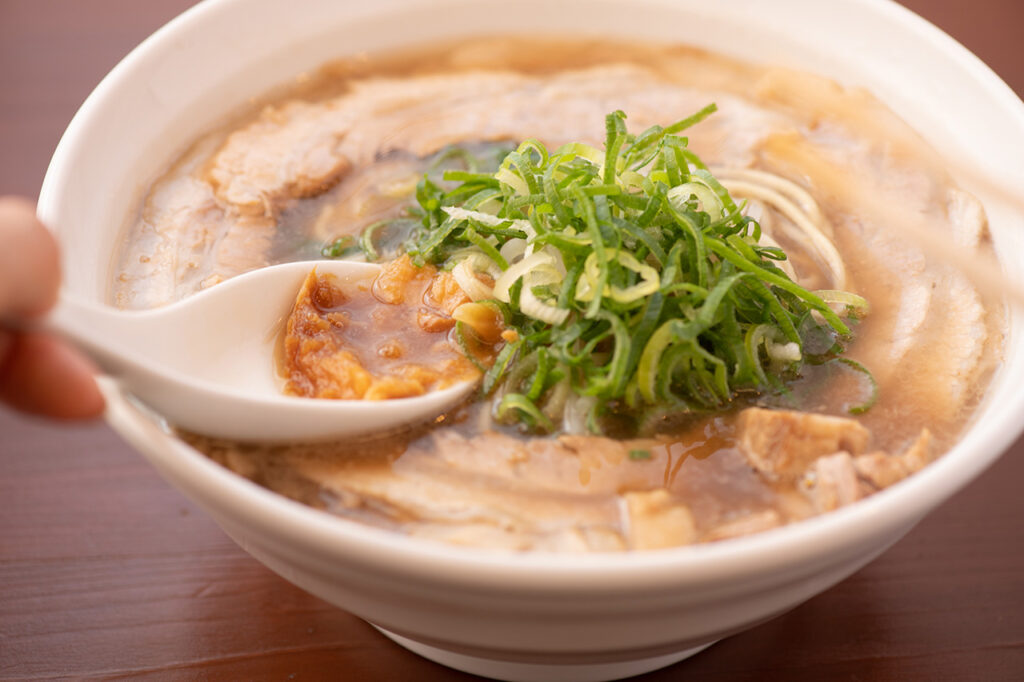
Ramen 800 yen. A bowl of clean, crisp, salty soy sauce. Toppings: pork belly chashu pork, kujo leeks, bean sprouts

As a sister restaurant of the popular Mugyu, Stamen Kashihara Honten offers a menu of Kyoto's old and new style ramen and gyoza (Chinese dumplings). Stamen Kashihara's special ramen is Kyoto's typical soy sauce. The soup is based on pork bones, and the Kaeshi, a pork seasoned soy sauce made from Kyushu's light soy sauce, is used as the base. The back fat is topped with A fat, which is characterized by its large size and sweetness, adding a richness to the robust flavor.

The ramen is 880 yen. The noodles are hand-rubbed flat noodles made by "Menya Eki E". Toppings are chashu pork, bean sprout, green onion, pickled bamboo shoot.

The family that once ran a diner in the Kyoto central market is now offering a fresh start with ramen, hoping to provide a place where workers can fill up on ramen. The ramen, which the family says was made with respect for the taste they have enjoyed since childhood, is made with a pork bone base soup, a special sauce blended with two kinds of soy sauce, and straight thin noodles, topped with bean sprouts and kujo leeks. It is one of the rare places where morning ramen can be enjoyed.
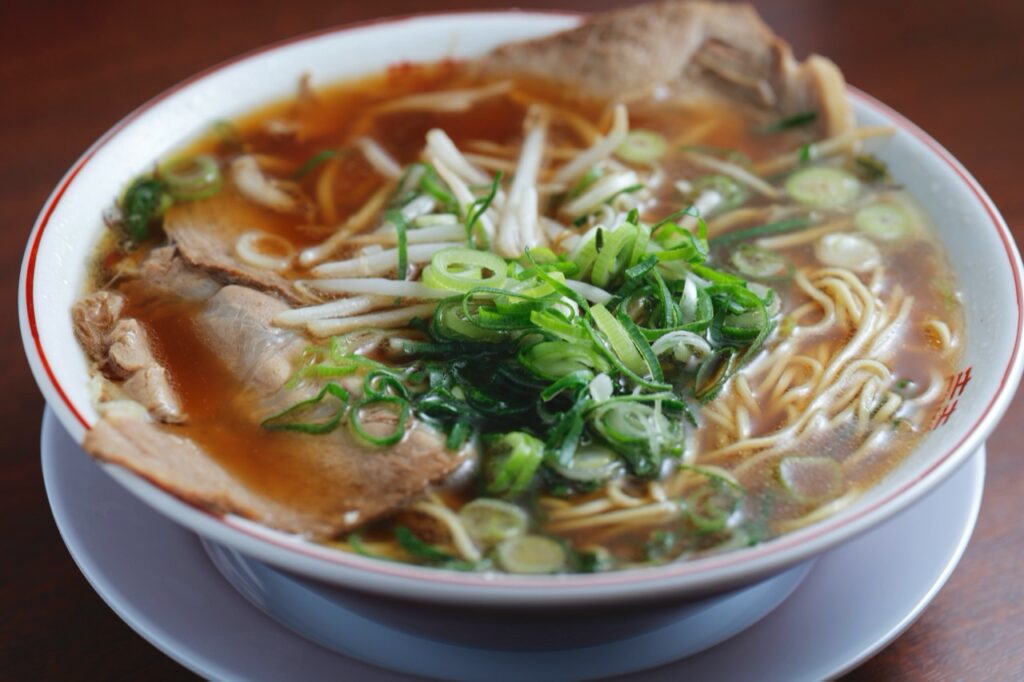
Ramen: 750 yen. Akira-style ramen without back fat. Light and crisp soy sauce flavor. Easy to eat even first thing in the morning.

The owner, Mr. Nagasue trained at Menya Makoto in Nagoya and opened the restaurant in Joyo, where he was born and raised. The salt ramen and soy sauce ramen use rare chashu pork and thin noodles, while Eijiro's salt and miso use thickly seared chashu pork and thick noodles. Eijiro's Miso, described as a "light Jiro-style," has a good balance of crunchy cabbage and bean sprouts and the delicious flavor of grated garlic.
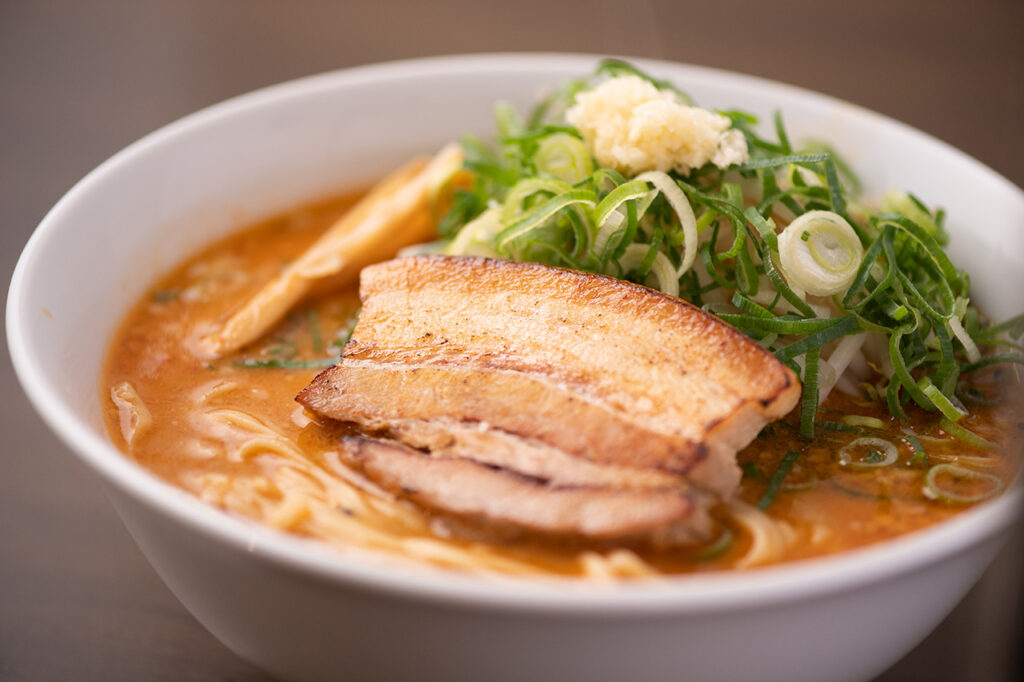
Eijiro (Miso) 900 yen. A blend of three kinds of miso soup with added back fat. Noodles for mazesoba and seared chashu pork also have a strong presence.

Rakurakushoku Sake Cornerstone, which had been a tavern for more than 16 years since its opening, was renewed as a ramen specialty restaurant. The second chapter of "Rakurakushoku Sake Cornerstone" is a new restaurant that specializes in Ramen, with thin noodles for Gokumi Chicken Shio Ramen and medium thin noodles for Gokumi Chicken Shoyu Ramen from Noodle House Ezhou. Check out the monthly noodle specials such as tantanmen and tai-dashi ramen.
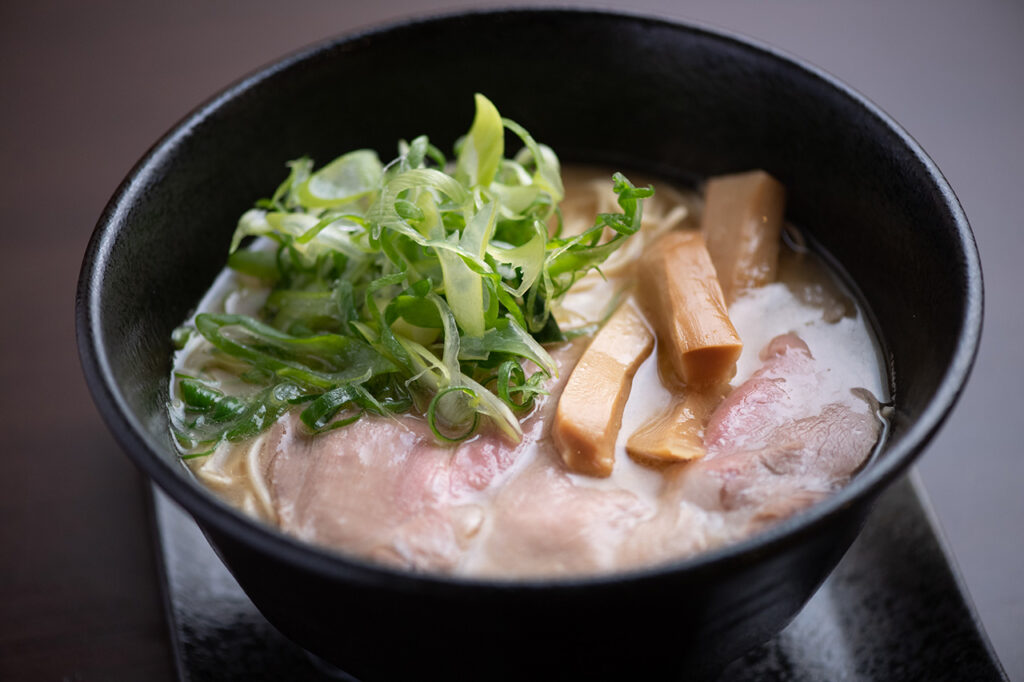
Extreme chicken soy sauce ramen 800 yen. Medium-thin straight noodles with the flavor of our signature chicken stock. The pork shoulder loin chashu is also moist and delicious.

A restaurant offering healthy ramen that does not contain any animal ingredients or wheat was born in Gion. Yukiko Uno, a pastry chef and plant-based cuisine researcher, spent four years developing this special soymilk ramen, which has a strong ramen-like punch. The after-feel of the ramen is also unique to vegan ramen.
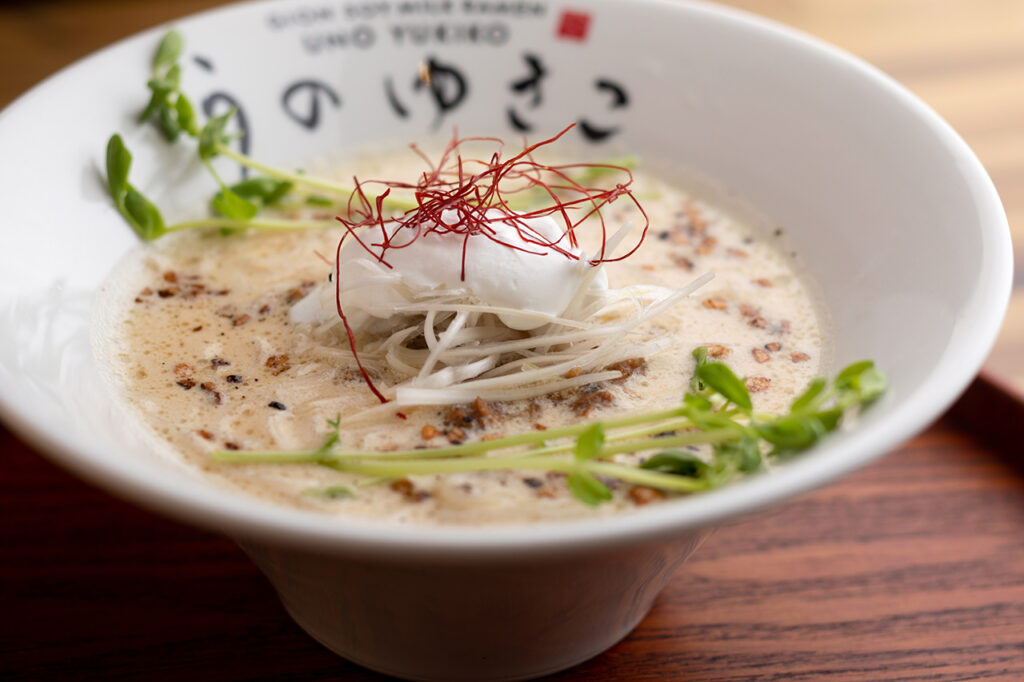
Soy milk ramen “Yuki” 1200 yen. The firm and rich soup is based on a mushroom and vegetable broth, combined with soy milk and gluten-free soy sauce. The noodles are original noodles made from rice flour and kelp, and have a delicious smooth texture.

A new project by Mr. Hiromasa Hiraoka, owner of the famous Sapporo restaurant "Japanese Ramen Noodle Lab Q," has started in Kyoto following Tokyo. The clear soup made with domestic ingredients such as Hinai Jidori chicken from Akita Prefecture and Nagoya Cochin from Aichi Prefecture, the rich flavor of soy sauce freshly brewed in Hyogo and Hiroshima, and the smooth texture of the homemade noodles made mainly from Hokkaido wheat are all unique and one-of-a-kind.
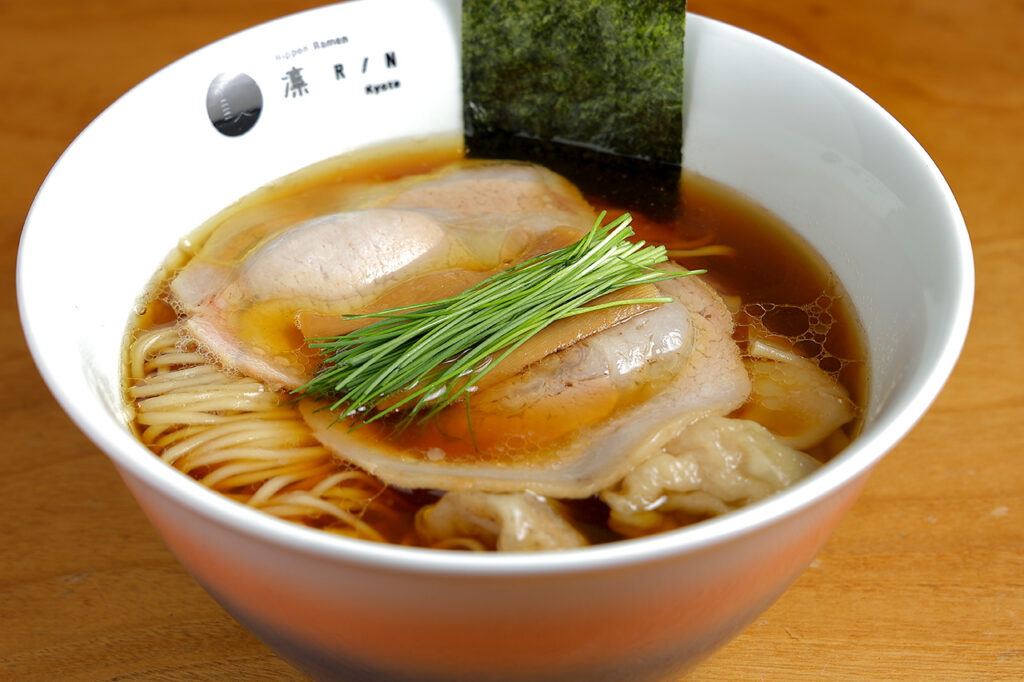
Soy sauce wonton noodles 1550 yen. Homemade noodles made in the back of the store, Hinai chicken, Nagoya Cochin fresh water, kaeshi blended with 5 types of soy sauce, topped with 2 types of wontons for a luxurious bowl.

The owner, Mr. Sakakimoto, was conscious of creating a restaurant that is easy to enter, with chairs for kids and paper napkins available, even for those with small children and grandparents. There are five types of noodles on the menu, including potage-like mild chicken shirato-yu, seven types of seafood soba, mazesoba, and a limited edition miso chicken shirato-yu.
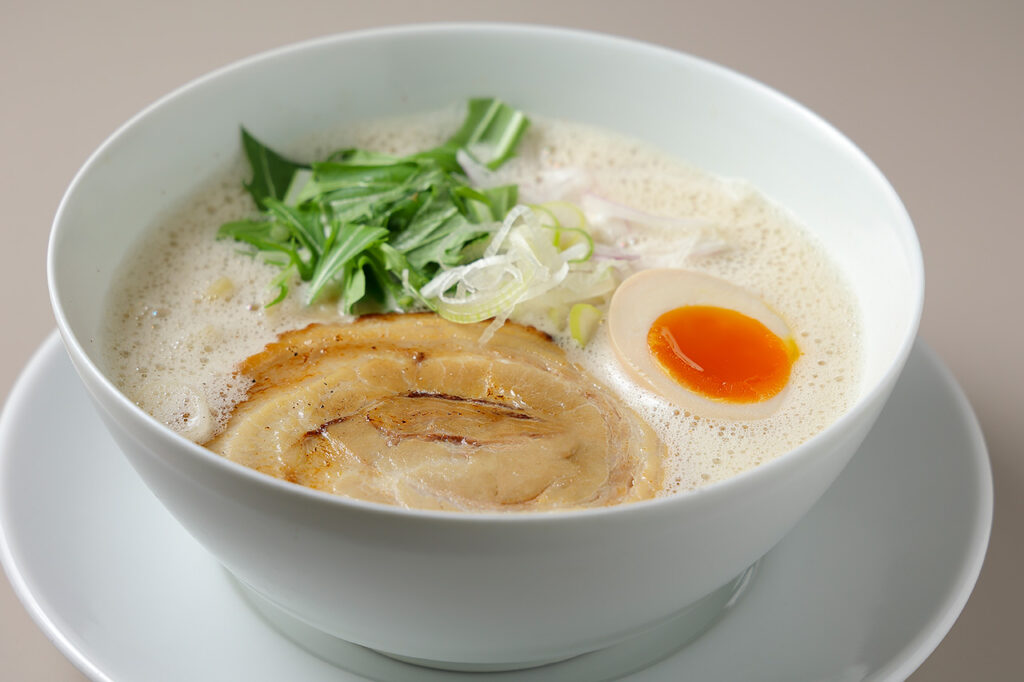
Chicken Shiratsuyu Soba 930 yen. The thick chicken and pork broth, made mainly from Kagoshima chicken bones and pork bones from Kyushu, is simmered over high heat to create a mellow, thick soup! The emulsification of the soup in a blender, one cup at a time, gives the soup a gentle, potage-like aftertaste with a rich animal flavor!

Fujiken Ramen is a new face near the Inariyama Tunnel and Yamashina IC. The owner, who is such a ramen fanatic that he eats ramen almost every day, opened the restaurant in the hope that "there would be a ramen restaurant in the local area that everyone can enjoy. He carefully prepares five types of ramen, including four standard types and one limited-time-only type, one at a time. The one that first-time visitors should definitely try is the signature dish, shoyu-soba with back fat and soy sauce.
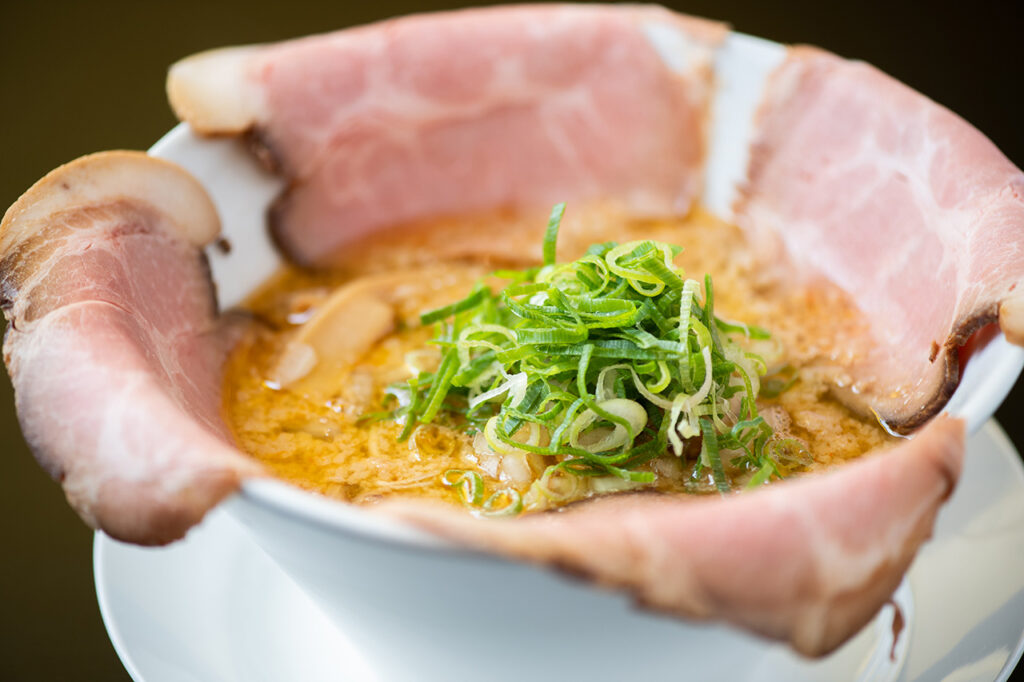
Fat soy sauce soba 800 yen. The soup has a sweet taste and the sharpness and richness of soy sauce.The soup is based on chicken stock and is seasoned with grains, garlic, ginger, and soy sauce made from Matsuno Soy Sauce. We also recommend adding extra char siu for an additional 200 yen.

Hayato Kimura, owner of the popular Nishijin ramen restaurant "Mendokoro Ganki," which regrettably closed in April 2022, opened a new restaurant near Kinkakuji Temple as the second chapter of his ramen life. Mr. Kimura, who holds numerous certifications such as dashi sommelier level 1 and dashi meister, can be enjoyed his ramen at his new location.
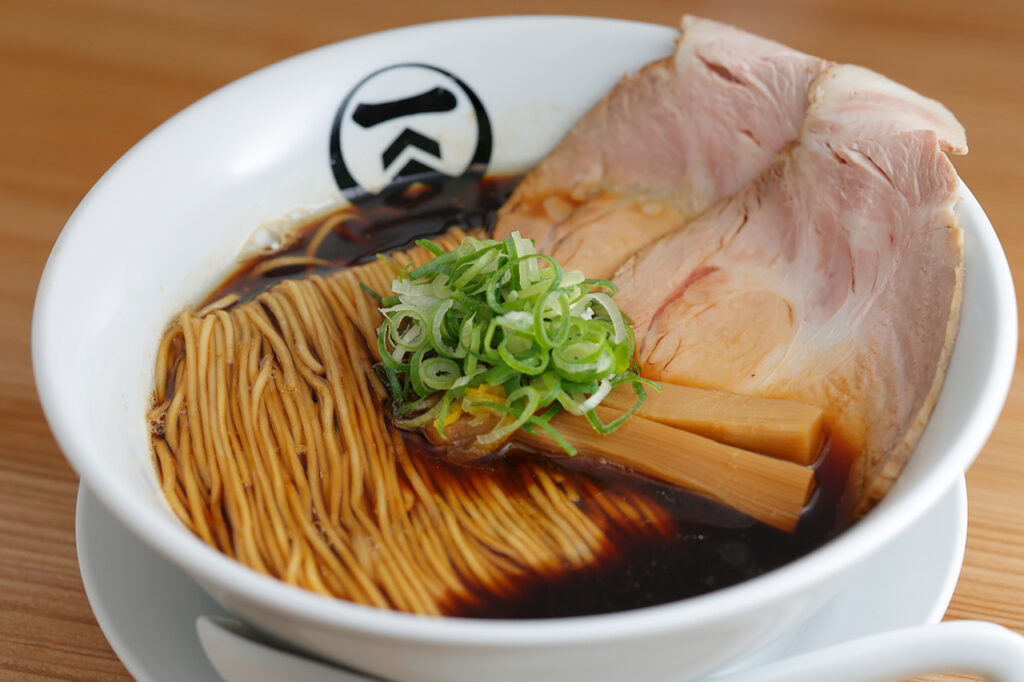
Fish broth soy sauce ramen: 850 yen. The broth is made from saba shavings, dried bonito flakes, dried sardines, and Rausu kelp, with a base of broth made from log shiitake mushrooms, dried oyster mushrooms, and surume seaweed. Kaeshi, three kinds of re-finished soy sauce and Mikawa Mirin (sweet cooking rice wine) are used to add umami and sharpness to the strong broth. Homemade noodles are made from Hokkaido wheat with a little whole wheat flour blended in.

The ramen restaurant "Mentori Baijori" is located in the back of a building on the north side of Gion, a hidden gem. With a counter seating eight, you can enjoy ramen in a relaxed kappo-like space. The menu consists of four types of ramen: two ramen with chicken broth, which is also the name of the restaurant, and two ramen with shellfish broth.
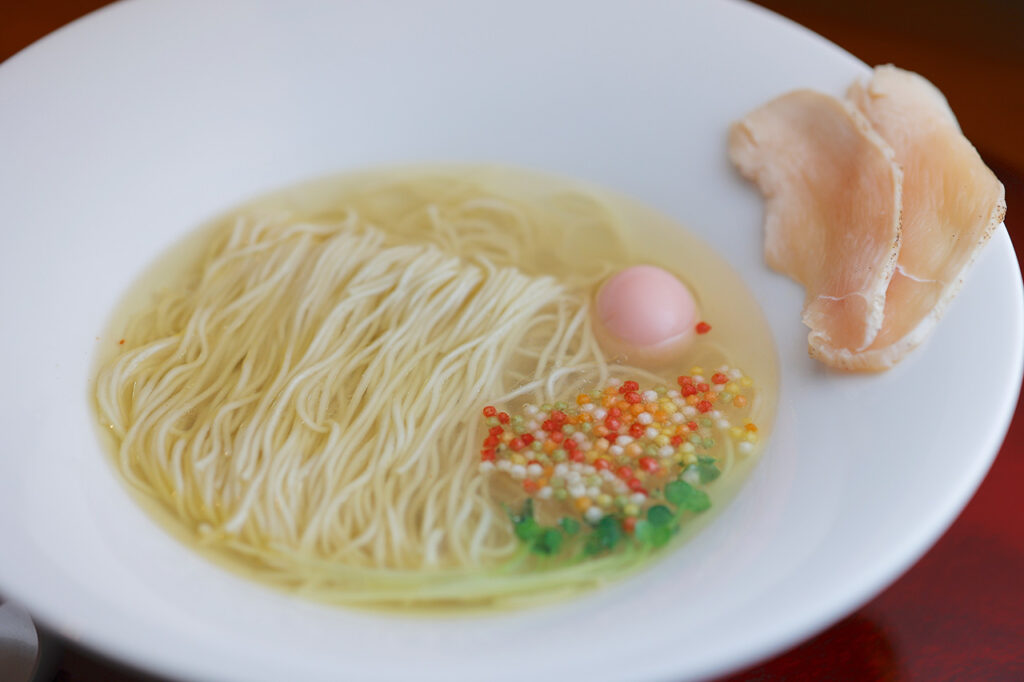
Chicken and salt plain soba noodles (1,380 yen). Contrary to its appearance, the clear soup has homemade chicken oil and garlic, and while elegant, it has a good punch. The noodles are thin and straight, made by an udon specialty restaurant. Most of the customers finish all of the soup before they know it!

Nabura, which was named by a staff member who loves fishing, refers to a school of small fish bouncing on the sea surface chased by larger fish. Words that can be a sign that someone big is out there. The staff wearing Nabura T-shirts, which symbolize the auspiciousness of the sea, serve ramen flavored with kelp and mackerel dashi.

Ramen average 880 yen. Seafood ramen with deep-fried mackerel topped with a nutritious soup of kelp and mackerel is a hot topic.

Over 600 interviews per year! An order site carefully selected by the editors who knows Kyoto and Shiga.
nowOfficial LINE friend registration500 yen OFF coupon is being issued!
Distributed every Friday morning at 8:00 am! From new restaurant information to event information that we want to share with you, We deliver articles about Kyoto that are useful to know. About 20,000 people have registered.Click here to add a friend!
 News
News Feature article
Feature article Featured event
Featured event